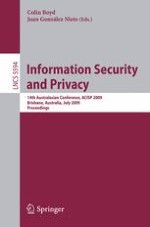The 2009 Australasian Conference on Information Security and Privacy was the 14th in an annual series that started in 1996. Over the years ACISP has grown froma relativelysmall conferencewith a largeproportionof paperscoming from Australia into a truly international conference with an established reputation. ACISP 2009 was held at Queensland University of Technology in Brisbane, d- ing July 1–3, 2009. This year there were 106 paper submissions and from those 30 papers were accepted for presentation, but one was subsequently withdrawn. Authors of - cepted papers came from 17 countries and 4 continents, illustrating the inter- tional ?avorof ACISP. We would like to extend our sincere thanks to all authors who submitted papers to ACISP 2009. The contributed papers were supplemented by two invited talks from e- nent researchers in information security. Basie von Solms (University of Joh- nesburg), currently President of IFIP, raised the question of how well dressed is the information security king. L. Jean Camp (Indiana University) talked about how to harden the network from the friend within. We are grateful to both of them for sharing their extensive knowledge and setting challenging questions for the ACISP 2009 delegates. We were fortunate to have an energetic team of experts who formed the Program Committee. Their names may be found overleaf, and we thank them warmly for their considerable e?orts. This team was helped by an even larger number of individuals who reviewedpapers in their particularareasof expertise.
